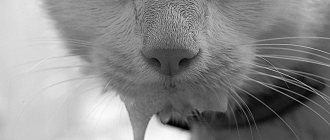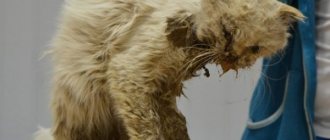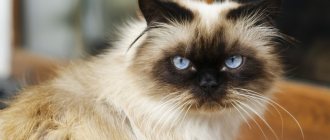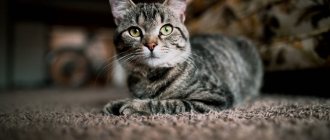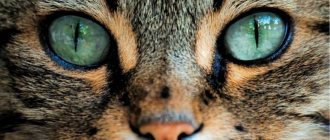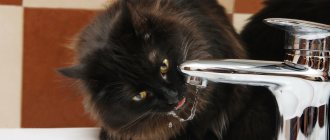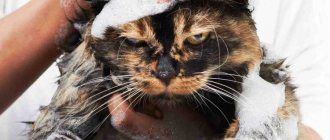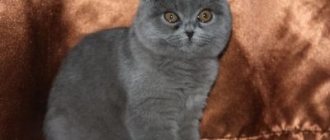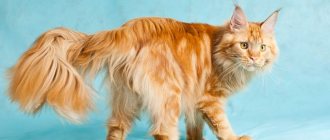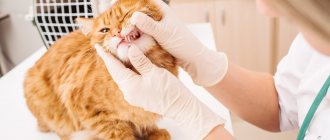Saliva in cats is important for the normal functioning of the body. It protects teeth and oral mucosa from damage, helps in the processes of chewing and swallowing food. But when a cat drools quite profusely, then this is a sign that something is wrong with the pet. Increased salivation in a cat is a sign of ill health and malaise in the pet. In this article you can find out the answer to the questions why this happens and what needs to be done about it.
Signs of excessive drooling
The presence of food or any irritant in the cat's mouth causes the production of saliva. Sometimes increased secretion of glands occurs for other reasons. You can notice the manifestation of drooling by characteristic factors in your pet’s behavior:
- often rubs its muzzle on the corners of furniture to get rid of accumulated excess;
- the cat often swallows and rubs its muzzle with its paw;
- The pet's tongue seems to fall out of the mouth and becomes flaccid.
Cat drooling
Drools flow in different ways:
- actively in streams or drops;
- slowly, imperceptibly at first glance.
An observant owner will notice the appearance of dampness in the places where the animal sleeps, the accumulation of wet fur, “icicles” on the pet’s neck and paws.
Signs of increased salivation
Hypersalivation in cats can have different degrees of severity, the weakest of which are noticeable only to an attentive owner.
Signs that indicate excess saliva production:
- swallowing movements;
- licking;
- rubbing the muzzle on all protruding surfaces;
- untidy appearance of wool without changing the conditions in the apartment;
- odorless wet spots on the cat's bedding;
- lolling tongue;
- “icicles” on wool;
- wet front paws;
- hanging strings of saliva on the muzzle.
A sign of pathology is if any of the above occurs constantly, and the pet’s condition does not improve over time. If you cannot independently determine the cause and eliminate the cat’s drooling, you need to take your pet to the veterinarian.
Saliva secretion norms
Saliva should not flow from the cat's mouth. But the appearance of drops on the muzzle is often associated with feeding habits. The need for active fluid production arises when feeding dry food to soak the granules. Eating wet food requires a small amount of saliva, although eating raw meat is accompanied by active gland activity.
Washing after eating
Normal salivation is called salivation, increased salivation is called hypersalivation. Increased drooling is sometimes a harmless manifestation, but together with additional symptoms of disorders, it reflects the development of pathology. Only a veterinarian can help you find out why your cat is actively drooling.
Non-communicable pathologies
During its life, the animal acquires common diseases that are not dangerous to humans and are accompanied by drooling.
Education
The only way to clean a cat's fur is to lick it. Over time, clumps of fluff accumulate in the esophagus, making it difficult for food to move through it. The body tries to get rid of these formations, salivation becomes more active (more often during the molting period).
The pathology is accompanied by other symptoms:
regurgitation;- refusal of food;
- increased thirst;
- constipation;
- bloating.
After defecation, hairballs are found in the animal's feces.
Poisoning
Excessive salivation is caused by toxins.
A cat can eat a poisonous plant, rodent poison in food, a medicine, spoiled food, lick flea treatment or pet shampoo from its fur. Mercury salts also provoke severe salivation.
Allergy
An allergen that enters a cat’s body causes an immune reaction, accompanied by itching, rash, and increased salivation.
Neoplasms in the head and neck area
Lymphomas - malignant neoplasms in the head and neck area in cats do not appear immediately. The first symptom of pathology is drooling.
Metabolic disorders
Such systemic diseases develop due to pathologies of the liver and kidneys. In the acute phase, if the therapeutic diet is violated, drooling may occur.
With an exacerbation of ulcers, colitis, or other problems with the digestive system, excessive salivation, nausea, putrid breath, and regurgitation appear.
Causes of hypersalivation
Excessive salivation occurs for many reasons. The most common manifestations are associated with:
- with physiological processes,
- with nervous tension;
- with the development of pathology.
The impact of provoking factors is observed in cats of different breeds and ages. If there is pathology in behavior, changes are also possible:
- decreased appetite;
- lethargy or, conversely, excitability;
- vomiting, diarrhea;
- itching;
- cough;
- elevated temperature.
Manifestation of hypersalivation
If the manifestation of hypersalivation, i.e. deviations from the norm are observed frequently and require diagnosis.
Preventive actions
How to prevent hypersalivation in your pet:
- monitor the condition of your gums. Brush your pet’s teeth with a special brush 2 times a week, and also examine the oral cavity for the presence of inflammatory processes;
- try to protect your cat from stress;
- do not give the animal fish with bones;
- feed your pet only high-quality food;
- keep household chemicals away, do not leave bleach, building materials, etc. open;
- avoid contact of the cat with street animals;
- Give your pet anti-worm medications once every 3 months;
- when removing fleas, make sure that the cat does not lick the preparation intended for topical use;
- do not give the animal any medications without first consulting a doctor;
- Be sure to give your cat all the necessary vaccinations;
- Take your pet to the veterinarian once every 6 months. After all, only a specialist can recognize minor deviations from the norm at the initial stages.
To prevent hypersalivation and inflammatory processes, your cat’s teeth should be brushed 2 times a week.
Attention! If the animal is often outside, then you need to bathe it once every 2 weeks. It is important to check your pet for fleas, which are carriers of helminths and various diseases.
To prevent increased salivation in the cat, as well as dangerous consequences for the gastrointestinal tract, I tried not to give my pet fish with bones. My favorite loved this product and even tried to steal the herring right from the table, but I either refused the cat such a delicacy, or first cleaned the fish from the bones. I also tried to feed my pet only high-quality products.
Normal salivation. Causes not related to illness
The physiological processes of salivation in healthy animals reflect the reactions:
- for food. Secretion is increased by the strong smell of food, habituation to eating at a certain time, unusual dishes;
- on accumulations of hair in the esophagus after licking. The cat will be able to get rid of the lump after producing saliva for regurgitation;
- for teething in kittens. After the process is completed, salivation returns to normal;
- to heat and high humidity. To restore heat exchange, they open their mouth, and saliva may flow from their tongue.
Normally, excess fluid appears in some typical situations when the owner should not panic, but should take preventive measures to eliminate the provoking factors.
Taking a bitter medicine or licking a chemical substance
In the process of preventive measures or undergoing a course of therapy, the animal takes anthelmintic, antispasmodic, and painkillers. The physiological need to get rid of bitterness and unpleasant taste in the mouth is associated with increased production of saliva. The intensity of the discharge depends on the volume of the medicine and the time of administration. Sometimes, with long-term use, saliva flows even before taking the drug.
Cats licking homemade cleaning products after use will also cause hypersalivation. It is important to prevent intoxication and monitor the safety of your pet if it is attracted by the smell of household chemicals.
Anesthesia
A cat under anesthesia
Deep immersion in natural sleep, associated with maximum muscle relaxation, is the cause of excessive drooling. A similar state of anesthesia, artificial sleep, is also marked by a similar manifestation. Salivation returns to normal after replenishing the lost volume of fluid.
Veterinarian intervention for such manifestations is not required unless there are additional signs of weakening of the body.
Great hunger
The cause of hypersalivation is often a long break between meals. The provoking factor is regular feeding, to which the animal gets used to. Excessive drooling signals a biological readiness to digest food, a real feeling of hunger.
Frequent failures in hourly feeding lead to premature production of gastric juice and increased acidity. This provokes not only increased salivation, but also the development of dangerous erosions or ulcers. Owners are advised to monitor the regularity of their cats’ meals and avoid long breaks.
Motion sickness while traveling
Long trips lead to motion sickness in cats. Symptoms of nausea and sometimes vomiting reflect a worsening condition. Increased secretion of saliva is typical for hypersensitive pets who react anxiously to any changes in their usual environment. The inner ear apparatus, which is responsible for balance and balance, signals extra movement, which leads to stress.
Cat on the train
Sometimes drooling becomes a conditioned reflex - a stable connection is formed with traveling in a car or other transport. By taking preventive measures on the recommendation of a veterinarian, the undesirable phenomenon can be eliminated.
Excess of affection
Cats of breeds with elongated faces, Orientals, Sphynxes, tend to drool at moments of complete muscle relaxation, as evidenced by the cat’s gentle purring. Attached to their owners, affectionate, accustomed to frequent stroking, the animals purr for a long time, expressing pleasure from communication, and slobber on their owner.
A similar manifestation of “tenderness” is also found in other breeds of cats, but less frequently. If the phenomenon is frequent and intense, it is recommended to consult a veterinarian to prevent the development of pathology.
Foreign object in teeth
Pieces of food stuck between the teeth, small fragments of bones, and random objects grabbed by the cat while eating are a serious cause of excessive drooling. The reflex work of the glands does not stop, although the animal gradually gets used to the discomfort.
Inspection of the mouth
If a cat licks itself for a particularly long time after eating, or intensively rubs the place where a foreign object is located with its paw, then you need to examine the oral cavity, find and remove the cause of the pet’s anxiety. It is advisable to treat the place where the piece is stuck with an antiseptic to prevent gum inflammation. In difficult cases, it is better to consult a specialist.
Old age
Older cats are prone to drooling due to problems with worn teeth and gums. Increased production of saliva is necessary to neutralize the action of bacteria, eliminate pathogenic flora in the oral cavity, if there are ulcers, or wounds on the cheeks from broken teeth. Cats over 14 years of age require frequent preventive examinations to prevent and treat gingivitis, periodontal disease, caries, and various inflammations.
If your pet has a smelly mouth or worn-out teeth, veterinary care and recommendations for changing its diet are required.
Causes of excessive drooling in cats
Factors influencing saliva secretion are divided into 3 groups: physiological , psychological , pathological .
The first two do not require medical attention. The third includes diseases and injuries that are diagnosed in a clinic and treated under the supervision of a doctor.
Physiological
Salivation increases due to external stimuli:
- Reaction to food . The sight and smell of food increases the secretion of gastric juice and saliva. When an animal gets used to eating at the same time, they are excreted during feeding hours and without food. Hypersalivation is noticed after unusual dishes.
- Hairballs in the gastrointestinal tract . A cat swallows hair when licking its fur coat. Salivation intensifies when they enter the esophagus due to irritation of the walls. In the stomach, the hair combines into a lump; in order to regurgitate it, additional liquid is needed.
- Medicines . Drooling increases due to the bitter, sour taste of the tablets, when licking the fur after treatment with flea drops. When an overdose of external preparations against ectoparasites occurs, the cat produces foam from its mouth, this is indicated in the instructions.
- Increased humidity and air temperature . In the heat, cats stick out their tongues and saliva drips from it. This way they restore heat exchange and escape the stuffiness.
- Pieces of food between teeth . A foreign body in the mouth irritates the mucous membranes. In an attempt to get rid of it, the cat rubs its muzzle with its paw and saliva flows profusely. In this case, the mouth is examined and the piece is carefully removed with tweezers.
Salivation returns to normal 15 to 30 minutes after the irritant is eliminated.
Psychological
Saliva is produced during moments of nervous tension; provoking factors include:
- moving, changing the usual environment;
- the appearance of other animals in the apartment;
- contact with an unfamiliar dog;
- games with children;
- visiting a veterinary clinic, medical procedures;
- travel in transport.
Hypersalivation goes away when the cat calms down and returns to its usual conditions.
Pathological
When there are no apparent reasons for ptyalism, internal disorders are suspected; they are accompanied by other unpleasant symptoms:
Pulmonary edema
How to treat a cat with diarrhea and vomiting
Dandruff
- Viral infections . Saliva is produced profusely when infected with rabies. The animal's coordination is impaired, swallowing muscles fail, convulsions occur, behavior changes - the cat hides or becomes aggressive, is afraid of light and water. With calcivirosis, the virus affects the mucous membranes and worsens health. In addition to saliva, the cat produces mucus from the nose, tears flow, and diarrhea occurs. Ulcers spread on the tongue and palate. Body temperature rises, which provokes thirst and nausea. The animal looks depressed and loses its appetite.
- Food intolerance . The reaction occurs when the food is changed, in addition to profuse salivation, the cat begins to have diarrhea and vomiting.
- Foreign body . Swallowed objects and bones injure the esophagus, stomach, and throat. The pet refuses to eat, constantly drinks, tilts its head unnaturally, coughs, and rubs its cheek on objects.
- Poisoning . Nausea with excessive saliva production is caused by spoiled food, household chemicals and cosmetics, poisonous plants and insects. With severe intoxication, vomiting and diarrhea with blood begins.
- Inflammation of the mucous membrane of the mouth, dental diseases . Hypersalivation occurs in response to the accumulation of bacteria. With stomatitis, ulcers and abscesses are noticed; with gingivitis, the gums turn red and bleed. The cat eats worse and chews food slowly. A repulsive odor appears from the mouth.
- Chemical burn . Injury occurs when acid or alkali accidentally gets on the mucous membranes after licking off iodine. The visible surfaces of the mouth swell, turn red, the tongue becomes enlarged, areas with a whitish coating and blisters appear. Breathing and heart rate increase.
- Diseases of the abdominal organs . Constant drooling and the smell of rot from the mouth accompany gastritis, ulcers, colitis, pathologies of the spleen and gall bladder. The cat refuses to eat, which leads to exhaustion.
- Other diseases . Hypersalivation sometimes begins with pyelonephritis, liver pathologies, malignant tumors, diabetes mellitus, and helminthiasis.
If the listed symptoms are noticed against the background of drooling, the cat is taken to the clinic.
Main diseases and conditions causing pathological hypersalivation
Excessive drooling is often accompanied by accompanying symptoms. The animal loses its appetite and its behavior changes. The pet becomes lethargic, sometimes, on the contrary, excited and aggressive. The most severe pathology associated with hypersalivation is rabies, an incurable disease. If the cat is domestic, then the risk of infection is extremely low. A visit to the veterinarian will quickly alleviate concerns. But there are other diseases for which it is also necessary to go to a veterinary hospital. Pathologies can be associated not only with the oral cavity, but reflect dysfunction of the entire body.
Poisoning
Sick kitten
A cat's excellent sense of smell is a natural defense against poor quality food. But still, natural curiosity and hunger sometimes fail. In addition to copious salivation, vomiting and diarrhea occur. If the cause of poisoning is related to food, then the pet needs to rinse the pet’s stomach with a weak saline solution and give it water with dissolved activated carbon (1 tablet per glass of water).
When the measures taken do not help, you need the help of a specialist. In cases of chemical poisoning, self-medication is destructive. It is important to urgently take your pet to a veterinary clinic.
Oral diseases
The cause of hypersalivation is a cyst of the salivary glands, blockage of the ducts, leading to swelling and inflammation. Treatment, depending on the severity of the manifestations, can be surgical, conservative, or mixed.
The development of gingivitis follows the appearance of caries and the formation of tartar.
Inflammation of the gums is eliminated with medicinal gels, vitamin solutions, and ointments. Antibacterial drugs are aimed at maintaining the body.
Trichobezoar
Every owner is familiar with regurgitation of undigested fur. Naturally, the pet gets rid of lumps, or trichobezoars, formed in the stomach. But large accumulations sometimes cannot come out on their own either through the anus or through the esophagus. Animals refuse to eat, do not lick themselves, and do not allow themselves to be petted. Stool and vomit contain inclusions of cat hair. The entry of a wool plug into the intestines provokes obstruction and requires urgent intervention.
Medicine for a cat
You can help with the problem of trichobezoar in the stomach with medications, and in special cases - with surgery.
Infectious diseases
Hypersalivation is a concomitant symptom of severe infectious diseases:
- feline leukemia - damage to the immune system by a virus. Manifestations in the form of stomatitis and gingivitis are constantly accompanied by active salivation. The disease is incurable. With the help of medicines, procedures, care, you can only prolong life;
- feline calicivirus - pathology of the upper respiratory tract is manifested by conjunctivitis, flow of saliva, ulcers in the mouth, and nasal discharge. Treatment is carried out with immunostimulating, decongestants, and anti-inflammatory drugs.
Allergic reactions
There are many external irritants that cause signs of allergies in cats:
- smells of household chemicals;
- cigarette smoke;
- insect bites;
- food additives, etc.
Symptoms that should alert owners are sneezing, heavy breathing, muscle spasms, drooling, tissue swelling, etc.
You can identify the allergen and help your pet cope with the consequences after consulting a veterinarian. Self-medication is contraindicated.
Diseases of the digestive tract and liver
Gastrointestinal problems are often indicated by inclusions (mucus, blood, undigested pieces) in feces and vomit. Excessive secretion of saliva, yellowness of the mucous membranes, odor from the mouth are symptoms of various pathologies - gastritis, enteritis, etc. First, there is a threat of dehydration of the cat, then the risk of failure of the animal’s diseased organ increases. Treatment of gastrointestinal diseases is accompanied by a strict diet for the pet.
Oncology
The development of tumors in the body also provokes increased salivation. Early diagnosis is difficult due to the lack of symptoms in the early stages of the disease. Owners turn to veterinarians, as a rule, too late, when it is no longer possible to save the animal. The risk of cancer is higher in older individuals, but occurs rarely in young ones.
Helminthiasis
Treatment with drugs
Salivation due to weight loss of the animal can be a signal for examination for the presence of helminthic infestations. Signs of infection with parasitic worms also include appetite disorders, stool disorders, and fever.
Even clean pets are susceptible to helminthiasis, so preventive measures and timely treatment are important to maintain the health of your pet.
Psychological reasons
Cats are susceptible to stress due to traveling in transport, being in a carrier for a long time, visits to the veterinarian, and moving. Manifestations of nervous tension are expressed by slight trembling, flow of saliva, avoidance of contact with the owners, and frequent licking of fur.
After eliminating the irritating causes, the condition returns to normal.
It is recommended not to subject pets to tests if the reaction is known in advance. Preventive measures in the form of sedatives help if the stress factor cannot be avoided.
Pathological causes
It is worth thinking about pathology if hypersalivation occurs at different times of the day and lasts more than 2 hours with a stable increase in saliva volume. Based on the accompanying symptoms, you should try to make a preliminary diagnosis yourself, since one of the possible causes is fatal to humans.
Virus: rabies, calcivirosis, rhinotracheitis
Drooling in cats occurs when infected with viruses. Depending on the symptoms, the pet may be infected:
- Rabies
. The most dangerous infection, accompanied by behavioral changes, photophobia and hydrophobia. If the disease occurs in a violent form, then the infected person can attack the owner. Any bite or scratch received from a carrier of the virus is deadly. Before the veterinarian arrives, be sure to isolate the cat in a separate room and do not come into contact with it.
- Calcivirus
. Severely weakens the body. Accompanied by vomiting, inflammation of the conjunctiva, stomatitis and damage to the respiratory system. May cause lameness and pneumonia. Treatment of the disease comes down to preventing secondary infection, which increases the likelihood of death to 80%. Additionally, symptomatic therapy is carried out to increase the immune response. As a result, the body destroys the virus on its own.
- Rhinotracheitis
. Causes depression and loss of appetite. The patient's temperature rises, rhinitis, cough and shortness of breath appear. Discharge from the eyes and nose may contain pus. Treatment is carried out by analogy with calcivirus. Without timely treatment, the disease develops into a chronic form. After recovery, 80% of whiskered patients remain carriers of the virus, so it is important to prevent them from coming into contact with other animals.
Please note that there is no cure for rabies. The only way to help a mustachioed pet is to prevent it from becoming infected. Preventive recommendations and vaccination will help with this.
Oncology – leukemia
Leukemia, or blood cancer, is a deadly pathology of the hematopoietic system. As a result of the proliferation of tumor tissue, healthy cells are replaced by malignant ones. The patient's immunity is suppressed, increasing the body's vulnerability.
The main danger of this disease is the absence of external signs. Blood cancer can be detected only by symptoms of secondary infections. The oral cavity is most often affected. The animal develops gingivitis and stomatitis, accompanied by abundant salivation.
Despite the lack of effective treatment, timely therapy prolongs the patient's life while maintaining his quality of life. In addition to a special diet, veterinarians use antibiotics, antiviral drugs and immunomodulators. In severe cases, a blood transfusion is required.
The cat is about to vomit fur
Periodic hair shedding is a natural process. Some owners specifically give their pets fresh grass that stimulates the gag reflex. As a result of burping, small balls of hair, or trichobezoars, come out of the cat's mouth.
Pathology is indicated when hairballs accumulate in the intestines. The resulting mass blocks the passage of feces, causing constipation, vomiting of undigested pieces of food and profuse salivation. Without timely help, the animal may die from rupture of the intestinal walls.
For treatment, medications are used that dissolve accumulated hairs and a special diet that normalizes digestion. Surgery is resorted to only in case of intestinal obstruction, when any stimulation of peristalsis is lethal for the patient.
Poisoning and nausea
Drooling, accompanied by frequent vomiting and diarrhea, is often associated with poisoning. Ingesting spoiled food, cleaning products, human medicines, or toxic plants can cause laryngeal muscles to spasm. If your cat's breathing is interrupted and his heartbeat increases, take him to the veterinary clinic immediately. Acute poisoning can be fatal.
To remove toxins, rinsing is used, but in case of poisoning, an antidote must first be administered. Otherwise, the condition of the mustachioed patient will worsen. After toxins are removed, the animal is prescribed infusion therapy and a gentle diet.
Oral diseases
With untreated caries, the animal develops gingivitis, that is, inflammation of the gums. In addition to increased work of the salivary glands, this pathology is accompanied by severe redness of the gums. An unpleasant odor may also appear.
Another possible cause of hypersalivation is a mucocele, or salivary gland cyst. With this disease, a blockage occurs in the duct of the salivary glands. The accumulating fluid leads to severe swelling.
Oral diseases left untreated can lead to tooth loss. Depending on the diagnosis, the veterinarian prescribes antibiotics, anti-inflammatory drugs, pain-relieving gels, or more radical methods of therapy. In advanced cases, diseased teeth are removed. This operation is performed under general anesthesia.
Infection with worms
The cat drools even with helminthiases. Infection is accompanied by loss of appetite and weight, bloating and hardening of the abdomen. Helminth waste products cause severe intoxication. The body uses vomiting and diarrhea to get rid of harmful substances. These symptoms are very dangerous for kittens - they can die due to dehydration.
Anthelmintic drugs are used for treatment. The medicine is given twice, as it does not affect the parasite eggs. Repeated administration of the anthelmintic kills the hatched larvae, preventing the next laying of eggs.
Allergy
Allergic reactions are accompanied by itching, redness of the skin, rhinitis and cough. Frequent interaction with an allergen is fraught with the development of bronchial asthma. It is better to show an animal with suspected allergies to a veterinarian. Antihistamines are used to suppress the effect of the allergen.
Gastrointestinal pathologies
If your cat is drooling, mucous membranes have turned yellow, vomiting and diarrhea have appeared - pay attention to inclusions in the feces and vomit. The presence of foreign inclusions (blood, mucus, pieces of undigested food) and a putrid odor from the mouth are the main symptoms of gastrointestinal pathologies: enteritis, pancreatitis, gastritis, colitis. All these diseases are dangerous not only due to dehydration, but also due to the failure of the diseased organ.
The type of therapy depends on the diagnosis, but in all cases it is recommended to follow a therapeutic diet. If necrosis is detected, surgery is performed to remove damaged tissue.
Reaction to stress
Prolonged nervous tension reduces the body's defenses, exacerbating chronic diseases and increasing susceptibility to infections. It is caused by travel in transport, visits to the veterinary clinic, moving and other alarming events for the animal. In addition to drooling, stress is accompanied by slight trembling, restlessness, active licking and avoidance of contact with the owners.
In addition to eliminating the irritating factor, veterinarians recommend calming medications with pheromones. They are produced in the form of drops, collars and diffusers with replaceable bottles.
Diagnostic methods
A complete diagnosis in a veterinary clinic helps to establish the causes of the disease. It helps to determine a possible pathology:
- history taking, examination;
- general, clinical analysis of blood, feces, urine;
- performing ultrasound, radiography, MRI.
Modern research methods make it possible to determine the condition of internal organs, study the functioning of the digestive system, determine the presence of helminthic infestation, trichobezoars, and possible injuries. The animal should be prepared for a number of procedures. For example, to conduct an ultrasound of the gastrointestinal tract, you should not feed for 10 hours.
Diagnostics
If your cat has excessive salivation, an unpleasant odor from the oral cavity, or constantly sticks out his tongue, then you need to undergo the necessary diagnostics in order to then begin effective treatment:
- The veterinarian will first carefully examine the oral cavity for the presence of any foreign bodies.
- Then you need to examine your tongue and teeth. Are there any inflammatory processes, wounds or chips?
- To rule out a foreign body stuck in the esophagus, you need to do an x-ray and ultrasound.
- A blood and stool test will help determine the presence of helminths in the body.
- A urine test will help identify disorders in the genitourinary system.
What to do and how to help your pet
Manifestations of excessive drooling are observed periodically in all cats. Owners should monitor what is causing the phenomenon, what irritating factors were the cause, and how long saliva has been secreted. If you are not sick, the disorder caused by physiological reasons will disappear after a short time.
Carrying out a cat examination
The appearance of saliva during travel can be prevented. On the recommendation of veterinarians, you need to purchase an anti-motion sickness medication and give it to your pet every time before traveling.
In difficult cases, when there is no obvious cause of the disorder, and the animal weakens, loses appetite, stops purring, or hides from its owners, you need to seek help from specialists in time. Excessive saliva may be a symptom of a serious illness.
When is this pathology?
The release of saliva in drops for a long time and for no apparent reason should alert the owner. There is a serious reason to see a doctor.
Attention! Continuous drooling is the main symptom of the most dangerous infectious disease - rabies. The animal develops photophobia and hydrophobia, and saliva drips from the mouth in clumps of foam. The cat begins to behave inappropriately. Rabies is a fatal disease for both animals and humans!
The flow of saliva also indicates other diseases:
- Diseases of the oral cavity and teeth. Constant drooling in a cat occurs against the background of inflammation of the gums, which become bright red. A foreign body may well get stuck between the cat’s teeth, which provokes stomatitis, purulent inflammation. The cat often refuses to eat, and if it does accept food, it chews very slowly and carefully, and its breath smells unpleasant.
- Oncology. Salivation and unpleasant odor from the mouth can cause malignant formations.
- Gastrointestinal problems (stomach ulcer, gastritis, colitis). The incorrect operation of this system is accompanied by an unpleasant odor from the animal’s mouth and becomes the reason why the cat drools. Food is poorly digested, this causes a fermentation effect, a feeling of nausea causes profuse salivation.
- Infectious diseases (botulism, tetanus). Against the background of nausea, cats drool profusely. The animal makes frequent swallowing movements and constantly licks its lips.
- Foreign object in the throat or esophagus. The animal coughs, does not eat, keeps its head bowed down, and clear drool flows from the cat’s mouth. Often in this situation, the owners themselves are to blame, feeding the animal food with bones (fish, chicken), which he is not able to chew. This is a dangerous factor not only for the health, but also for the life of the cat.
- Poisoning. The release of large amounts of saliva is due to nausea. An animal can become poisoned:
- poor quality or unsuitable food for cats;
- household or industrial chemicals, cosmetics.
- Allergy. A common cause for hypersalivation. An allergic reaction often occurs to food and insect bites.
Flowing saliva
Ptyalism can become a symptom of many other diseases:
- diseases of the cardiovascular system;
- diseases of the endocrine system;
- colds;
- renal failure;
- parasite infestation.
Attention! It is difficult to independently determine the cause of excessive drooling. The temporary nature of ptyalism does not pose a threat. In other cases, only a veterinarian can solve the problem.
Consequences of self-medication
Lost time to provide assistance often causes complications and sometimes death of pets.
Most diseases do not go away on their own. It is necessary to treat with medications, the selection and dosage of which is prescribed only by a specialist. Inflammatory processes without proper attention shorten life. So, without treatment, gingivitis becomes chronic, the cat loses teeth, and digestion is impaired. Pain and frustration spoil the character of the animal.
The entry of foreign objects into the stomach and intestines leads to necrosis and tissue rupture. Waiting for the cat to get rid of the load on its own is dangerous.
Visiting the Veterinarian
Increased drooling is not always a harmless phenomenon. It is not always possible to cope with the problem without the help of a doctor.
Cats foam at the mouth. Reasons causing hypersalivation:
- infections (calicivirus, herpesvirus, rabies and others);
- stomatitis (inflammatory disease of the oral mucosa);
- gingivitis (inflammation of the gums);
- trauma to the mouth or tongue;
- caustic/caustic toxins (such as household cleaners and some indoor or outdoor plants);
- erosions and ulcers on the tongue and in the oral cavity;
- foreign bodies or tumors in the mouth and esophagus;
- neurological disorder of chewing or swallowing (paresis of the pharyngeal muscles due to botulism, etc.);
- nausea;
- certain metabolic disorders : hepatoencephalopathy - a disorder of the nervous system due to liver dysfunction;
- hyperthermia - increased temperature;
- uremia - the effect of toxins on the body due to impaired kidney function;
Prevention measures
It is easier for a sensitive owner to prevent many problems by being attentive to the pet. Veterinarians recommend:
- monitor the cat's diet;
- exclude bones from the diet;
- carry out timely antiparasitic treatments;
- comb out pets' fur during shedding;
- use special toys to clean your cat's teeth;
- follow vaccination schedules;
- remove household chemicals from pets;
- monitor the condition of your teeth and mouth.
Prevention of cat diseases is directly related to regular visits to the veterinarian. The appearance of excessive saliva in a pet is a serious reason to examine the animal.
Treatment
In the absence of serious pathologies, the animal can be helped at home . The stuck object is removed from the mouth, and after eating a bitter plant or taking medicine, the animal is given plenty of water.
Clinical researches
Upon admission to the animal clinic, the veterinarian conducts an initial examination of the cat. Then a series of examinations are prescribed to determine the cause of the pathology. Diagnostic methods:
X-ray of the head (allows us to identify pathologies in the roots of teeth);- biopsy of modified mucous membranes and tissues;
- general and biochemical blood test;
- X-ray of the chest and abdominal organs (for internal organs, the procedure is carried out with a contrast liquid to identify foreign bodies and neoplasms);
- analysis of urine and feces to detect inflammatory processes and helminthiasis.
Based on the results of the examination, a diagnosis is made. Treatment is prescribed at home or in a veterinary clinic. The cat is prescribed antibacterial agents, antiviral drugs, vitamins, and a therapeutic diet.
